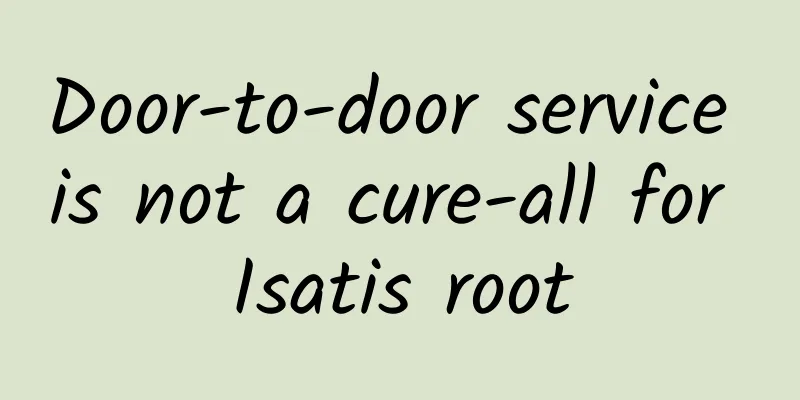Door-to-door service is not a cure-all for Isatis root

|
2014 was the year of the O2O industry explosion. The industry vertical media Yiou.com reported on O2O startup financing news every day. Small companies that could not even be found on Baidu announced financing of tens of millions of yuan. Door-to-door service subverted traditional stores and seemed to have become a hot topic. In addition to "curing all diseases", it could also "conquer" investors in one fell swoop. Diaoye's Beaver Home achieved a valuation of 1 billion yuan in half a year at a rate of burning 10 million yuan per month, which added fuel to the already hot O2O door-to-door service. A large number of start-ups with door-to-door service as their core selling point have come to the fore due to successful financing, and a large number of start-ups are also looking forward to replicating the "myth" of Beaver Home, making investors line up to pay, and then the losers will counterattack and reach the "peak" of life. There is no point in door-to-door service if it cannot improve efficiency O2O door-to-door service is not new. In fact, e-commerce has been around since the beginning. Take Taobao and JD.com as examples. Purchases take place online, while delivery and after-sales service are all offline. Door-to-door service has long been standard. This is also a perfect O2O ecological chain, but this industry has a very long history and has been excluded from the O2O development direction of advanced productivity by the media. From the perspective of Alibaba and JD.com, two e-commerce giants, door-to-door service is their big move. Traditional stores are going downhill under their impact. The biggest transformation that e-commerce has brought to the traditional retail industry is that it has improved transaction efficiency, accelerated the circulation of goods, and thereby reduced commodity prices to benefit consumers. Jack Ma and Liu Qiangdong have also become new wealthy elites through this. Back to O2O door-to-door service, it does not necessarily improve efficiency. Cleaning cannot be done without door-to-door service, which is not discussed here. But is it really reliable for industries that rely on traditional stores, such as nail art, beauty salons, massage and health care, car washing and car maintenance, to provide door-to-door service? Let’s take e-commerce, which has been verified as a successful business model, as an example. The offline scene where consumers and service providers have the most contact is picking up express delivery. Whether at work or at home, this interaction can be completed in a very short time (within 30 seconds). It is common for couriers to deliver 200 orders during peak hours, which is also an important part of the high efficiency of e-commerce. Imagine if the courier can only deliver 10 orders a day, who will be allocated the increased transaction costs? Let's look at the beauty industry O2O represented by Helijia. The most common interaction scenario is that technicians take orders and go to consumers' homes to provide services. Those who do manicures at work are either leaders or want to go home early for the New Year. If we further subdivide the users of manicures, they can be roughly divided into office workers and housewives. The most likely consumption time period for office workers is weekday evenings and weekends. If we exclude the late time and include weekday evenings, the consumption behavior of this part of consumers will be concurrent and time-concentrated (roughly guessed: 7 to 10 pm on weekdays, afternoon to evening on weekends); let's look at housewives. They have plenty of time and their consumption time periods may be more scattered, but because they have too much time and don't have to go out to show off to colleagues, it is a better choice for them to learn manicures for fun, or go shopping with their girlfriends and do manicures by the way. Zhou Tong, founder of nail polish brand CCO Caikou, a beauty industry practitioner, previously said that the mainstream group of people who accept door-to-door manicures are women between the ages of 25 and 35 with a monthly income of more than 10,000 yuan, which corresponds to the office workers mentioned above, or senior white-collar workers. Let's assume that all conditions are ripe and white-collar users are willing to accept door-to-door manicures. The biggest dilemma encountered by technicians when doing door-to-door manicures will be that the user consumption time periods overlap seriously. A single technician can only serve one user in a specific time period, and there will be no customers after the peak consumption period. Don't mention the excuse that technicians can work in the store during normal times. Do you think the nail salon owner will agree to it? Eat the boss's meal and smash the boss's pot? The above mentioned is a major bottleneck that the door-to-door nail service in the beauty industry O2O will encounter. This bottleneck is naturally formed and determined by the characteristics of the industry, just like the cleaning service must be on-site. This shows that the door-to-door service has not improved the efficiency of nail art. Compared with in-store nail art, the number of customers that the technicians of the door-to-door nail art can serve is likely to decrease instead of increase. Door-to-door service cannot improve efficiency, which is a fatal problem. If the efficiency is not improved, the scale cannot be increased. If the scale cannot be increased, the market cannot be developed. If the market cannot be developed, it is necessary to continuously burn money to find customers. This is a bottomless pit that no one can afford. This bottomless pit is encountered by startups that provide door-to-door services such as beauty salons, car washes and maintenance. Efficiency must be emphasized. Any business model that does not talk about efficiency and valuation is a hooligan. What kind of door-to-door service is available? Not all door-to-door services are reliable, but there are definitely some that are reliable. Still focusing on the keyword of efficiency, how to meet the needs of more users in a unit of time is the key to the development of O2O door-to-door services and the core issue that startups need to consider. For example, the food ordering software Ele.me has been a dark horse in the past year. It starts with collecting restaurant locations and menus, and provides online food ordering services. Meals and delivery are provided by restaurants, which can well solve consumers' short-term concurrent needs. On the other hand, door-to-door services such as manicures may have a single user profit that exceeds e-commerce and catering, but they cannot handle concurrent demands because the time cost of serving a single user is too high. In order to serve a certain scale of users, enough technicians must be reserved, and these technicians will be idle most of the time, which becomes a cost pressure that startups cannot bear. If you don't reserve technician resources, quality control is out of the question, and it's just a dream to want to grow big. This is a hurdle that all door-to-door service startups must face. If you can't get over it, you can't do it. It can be said that only industries that can handle concurrent demands have a chance to provide door-to-door services. If you want to expand, don't consider products and services with too high a customer price. High prices mean low frequency. Industries that have a chance, such as door-to-door delivery of vegetables, fruits, and meat, have high frequency. Vegetables, fruits, and meat are necessities in the family. If you cook by yourself, you need them every day. Second, it is convenient for centralized distribution. It can be delivered in batches according to the community. The time cost of serving a single user is not much different from that of the couriers of traditional e-commerce. This is equivalent to transforming the vegetable market, and it has significantly improved the efficiency of users buying vegetables. Many teams in Beijing, Shanghai, Guangzhou, and other first-tier cities have tried this, and many have received financing. As traditional giants have successively entered the popular O2O industry, door-to-door service is about to become a red ocean. Entrepreneurs who want to enter this industry should think more about where the opportunities are and whether their entry will help improve the efficiency of the industry. Those unreliable door-to-door services should stop early, because money will run out one day. As a winner of Toutiao's Qingyun Plan and Baijiahao's Bai+ Plan, the 2019 Baidu Digital Author of the Year, the Baijiahao's Most Popular Author in the Technology Field, the 2019 Sogou Technology and Culture Author, and the 2021 Baijiahao Quarterly Influential Creator, he has won many awards, including the 2013 Sohu Best Industry Media Person, the 2015 China New Media Entrepreneurship Competition Beijing Third Place, the 2015 Guangmang Experience Award, the 2015 China New Media Entrepreneurship Competition Finals Third Place, and the 2018 Baidu Dynamic Annual Powerful Celebrity. |
<<: US media: China will become a global leader in technology
>>: Terminal manufacturers quarrel over content shortage: the real dilemma of TV games
Recommend
A preliminary exploration of the application prospects of VR technology industry: technological innovation defines a wonderful future
In recent years, with the development of network ...
How much does a piece of Cordyceps sinensis cost in 2020?
How much does a piece of Cordyceps sinensis cost ...
What exactly is the first test of Beijing’s new college entrance examination? How is the new college entrance examination tested?
Beijing's new college entrance examination: T...
What are the functions of Guangzhou’s elderly care mini program development? How much does it cost to make a mini program?
At present, the elderly population in my country ...
If you don’t understand, just ask! Why does the phone remind you to charge when the battery reaches 20%?
Nowadays, people’s demand for mobile phones is in...
How to adjust the high cost of bidding ocpc? Done in 4 steps!
How to adjust the high cost of bidding ocpc? When...
Electric Technology Car News: Black technology or just empty promises? Can the Singularity IS6 of Internet car manufacturing make people feel at ease?
Today's traditional automobile market has bee...
7 major channels for promoting Douyin and increasing followers!
If it is an enterprise account, it is recommended...
Vivo Z6 is a performance pioneer, bringing 5G mobile phones into the 2,000 yuan range with a quasi-flagship attitude
Since 2018, many mobile phone manufacturers have ...
How to leverage Halloween? Combining 14 cases including Durex, Gucci, Ele.me, etc., we will teach you step by step!
Halloween is coming~~ The KFC posters downstairs ...
Open source code - WeChat friend analysis
[[233177]] This morning when I was looking throug...
How should we play “local self-media”?
The rise of local self-media is something that is...
Pinduoduo search term ranking rules
In the store's traffic structure, the accurac...
Why would Google open source its most important secrets?
Google's technology is one of the main drivin...









